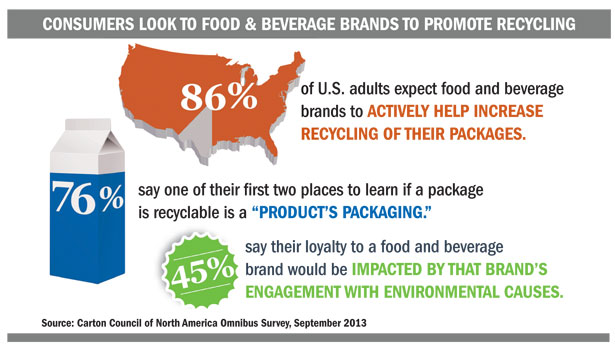What is our responsibility for the end-of-life of food and beverage packages in the U.S.? For decades, many operated on the belief that the private sector (brands, packaging producers, etc.) was primarily responsible for manufacturing environmentally friendly packages and that the public sector (local governments, regional authorities, etc.) was responsible for recovering those packages.
With ever-diminishing budgets, many local governments don’t have the funding they need to bring state-of-the-art recycling programs to residents by themselves. Material recovery facilities (MRFs) work to stay on top of the newest technology that makes recycling more efficient, but with the challenges of peaks and valleys in both volume and commodity pricing, it’s not always financially feasible.
All of this indicates that there is an increasing need for the public and private sectors to collaborate on finding and implementing recycling solutions in communities across the country. A recent survey conducted by Research+Data Insights on behalf of the Carton Council of North America in the fall of 2013 revealed that consumers overwhelmingly believe that product companies and their brands play a crucial role in recycling. In the survey, which included 1,000 adults from across the U.S., 86% responded that they expect food and beverage brands to actively help increase the recycling of their packages.
The survey also indicated that consumers look to the actual products they purchase for environmental information—even before turning to other resources, such as a city website. Seventy-six percent reported that they would look at the product’s packaging to learn if a package is recyclable. The second most popular place to determine recyclability was the product’s company website (33%), followed by the consumer’s city website at 26%. This validates that there is an increasing need for public and private collaboration.
The Carton Council of North America promotes and encourages a voluntary approach to producer responsibility where both the public sector’s and industry’s efforts need to be extended through voluntary collaboration to jointly fund and operate recovery systems. In other words, joint public and industry collaboration on programs, policy, governance and funding will result in maximum efficiency in the recovery of cartons—and other household recyclables as well.
The VPR+ formula (as the Carton Council refers to it) relies on the integration of recovery infrastructure, education, local and state participation and support of effective policies. In a particular market, private and public sectors can collaborate in three interconnected areas:
- Carts and Technology: Expand convenience with large rolling carts, maximize the types of packaging materials collected in local programs and adopt improved technology and overall capacity and efficiency of collection and processing operations.
- Education: Utilize community-based social marketing techniques designed to impact consumer behavior; implement or test potential incentive-type programs; partner with organizations already working in these capacities, such as the Curbside Value Partnership, Keep America Beautiful and/or Earth 911; and continually market programs to residents at a budget of approximately $1 per household.
- Policies: Support local recycling ordinances, state-level disposal bans for containers where the recycling infrastructure is available and mandated recycling to ensure that thoughtful effective policies support, rather than hinder, local recycling efforts.
The carton industry has been successful with this model. In 2009, the Carton Council of North America was formed through a collaboration of four market competitors in carton manufacturing, including Elopak, Evergreen Packaging, SIG Combibloc and Tetra Pak. Additionally, Weyerhaeuser, a paper product maker, is an associate member. These companies joined together to deliver long-term collaborative solutions to build a sustainable infrastructure for carton recycling. Over the past four years, the Carton Council has made significant advances toward expanding U.S. household recycling access for cartons. The substantial investments made have expanded the national collection infrastructure for cartons, as well as successfully created end markets for the fiber recovered from them. As of November 1, 2013, the national household access rate for carton recycling was 46%, an increase of more than 150% from the 18% access level in 2009. This number is expected to continue to rise this year to 50%, and then 60% and beyond over the coming years. Forty-five states and 68% of the 100 largest U.S. cities already accept cartons.
But let’s be honest. It is often difficult for brand managers to collaborate, especially among competing companies. There are countless worthy examples of the packaging industry having success in promoting food and beverage package recycling and this is not to suggest that the packaging industry halt individual brand efforts to promote the environment and recycling. The industry needs more cross-industry collaboration.
As part of the Carton Council’s focus on increasing access, financial and technical resources are offered to engage recycling professionals as well as the recovery facilities and mills needed to build the carton recycling supply chain. The Carton Council also support end market and recovery facility capital upgrades, assisting facilities to adopt the equipment needed in order to successfully incorporate cartons into a community’s recycling program. However, this is only one piece. Consumer education is key as well, especially where new packaging formats are involved.
As the research reiterates, brands need to utilize their packaging to educate consumers. They can start by adding the recycling logo to their packaging.
The phrase “a rising tide lifts all boats” is truly applicable, and everyone benefits from efforts to improve and promote recycling. Today there is a desperate need for true collaboration between the industry and public sectors to jointly find solutions that address the whole system, not just bits and pieces. Smart efforts and coordinated investments should address the overall health of the whole recovery program—understanding that there are multiple key elements to strong performance. Leveraging existing funding and resources in a coordinated way could bring the vision of strong and sustainable recovery into reality across the U.S. and result in a win-win for everyone.

